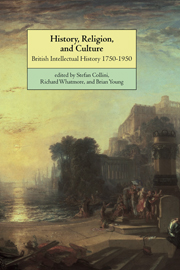Book contents
- Frontmatter
- Contents
- Preface
- General introduction
- Presentation of History, Religion, and Culture
- Part I
- Part II
- Part III
- 8 The politics of anatomy and an anatomy of politics c. 1825–1850
- 9 Images of time: from Carlylean Vulcanism to sedimentary gradualism
- 10 ‘Race’ and ‘nation’ in mid-Victorian thought
- 11 Political thought and national identity in Britain, 1850–1950
- List of contributors
- Acknowledgements
- Index
9 - Images of time: from Carlylean Vulcanism to sedimentary gradualism
Published online by Cambridge University Press: 03 December 2009
- Frontmatter
- Contents
- Preface
- General introduction
- Presentation of History, Religion, and Culture
- Part I
- Part II
- Part III
- 8 The politics of anatomy and an anatomy of politics c. 1825–1850
- 9 Images of time: from Carlylean Vulcanism to sedimentary gradualism
- 10 ‘Race’ and ‘nation’ in mid-Victorian thought
- 11 Political thought and national identity in Britain, 1850–1950
- List of contributors
- Acknowledgements
- Index
Summary
My subject is the representation of historical time: history, that is, as, for example, bounded and catastrophic or endless and, in its most profound and least perceptible ways, moving at a pace too gradual for the eye to measure directly. Also history as reassuring, as judgemental and punitive; as directional or as repetitive; as drama, plotted and portentous, or as indifferent; as governed by the same rhythms as the natural world, or as crucially distinct from it; ending with a bang; ending with a whimper; not ending.
I shall be concerned here with the period and place I know best: nineteenth-century England. Even here there are limitations to be stipulated. This essay focuses essentially on the early and middle years of the century, with a glance back at the late eighteenth. It does not go on to the end of the century so there is nothing here, for example, about a major theme in that period's apprehension of time: the doom-laden scene of a dying world like that encountered by H. G.Wells’ Time Traveller, which the later nineteenth century derived from the second law of thermodynamics. Of course, even within its avowed limitations, the essay is not comprehensive and all the usual caveats apply.
- Type
- Chapter
- Information
- History, Religion, and CultureBritish Intellectual History 1750–1950, pp. 198 - 223Publisher: Cambridge University PressPrint publication year: 2000
- 4
- Cited by

